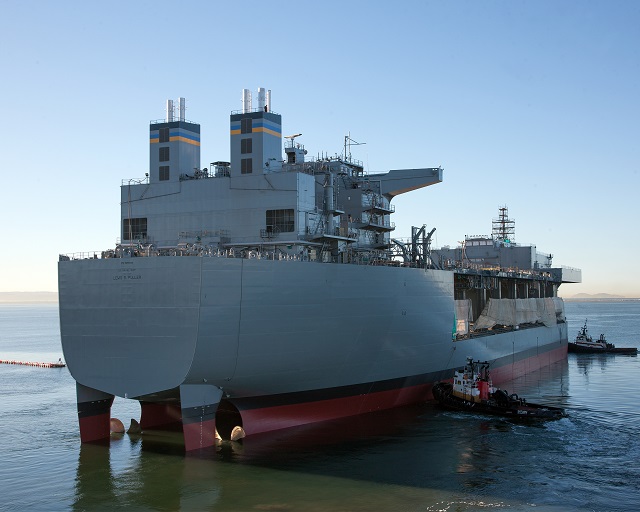 The ship is designed around four core capabilities - aviation, berthing,
equipment staging area, and command and control - and optimized to support
a variety of maritime missions. Picture: NASSCO
The ship is designed around four core capabilities - aviation, berthing,
equipment staging area, and command and control - and optimized to support
a variety of maritime missions. Picture: NASSCO |
|||
During
float-off, the launching dock was slowly flooded with water until the
ship could freely float for the first time. Following launch, the ship
will complete its construction and then go to sea in 2015 to complete
a series of at-sea test and trials prior to delivery in 2015. As one of the Defense Department's largest acquisition organizations, PEO Ships is responsible for executing the development and procurement of all destroyers, amphibious ships, special mission and support ships, and special warfare craft. Delivering high-quality war fighting assets - while balancing affordability and capability - is key to supporting the Navy's Maritime Strategy. |
|||
 The AFSB current design could be modified in order to accomodate MV-22
tilt rotor aircraft
The AFSB current design could be modified in order to accomodate MV-22
tilt rotor aircraft |
|||
Speaking
to Navy Recognition during the Sea-Air-Space 2014 exposition,
Tom Wetherald (Director of Business Development at GD NASSCO) explained
that there is an accommodation block located forward for up to 250 personnel
for the flight crew or other mission personnel such as Navy Seals or Marines.
This space also features a hangar capable of fitting two MH-53 helicopters
plus aviation maintenance and mission specific spaces. The ship retains the capability of ballasting down. Eventhough the ship is configured for air mine countermeasure missions with MH-53 helicotpers, NASSCO believes the US Navy is about to order a study on the ability of AFSB to handle the MV-22. It should not be a significant job to modify the existing design in order to handle the MV-22. AFSB will have an endurance of over 9,500 nautical miles at a speed of 15 knots. |
|||
GD NASSCO Successfully Launched 1st Afloat Forwarding Staging Base (AFSB) variant MLP
- Posted On





 The Lewis B. Puller successfully completed launch and float-off at the
General Dynamics National Steel and Shipbuilding Co. (NASSCO) shipyard
Nov. 6. Picture: NASSCO
The Lewis B. Puller successfully completed launch and float-off at the
General Dynamics National Steel and Shipbuilding Co. (NASSCO) shipyard
Nov. 6. Picture: NASSCO




